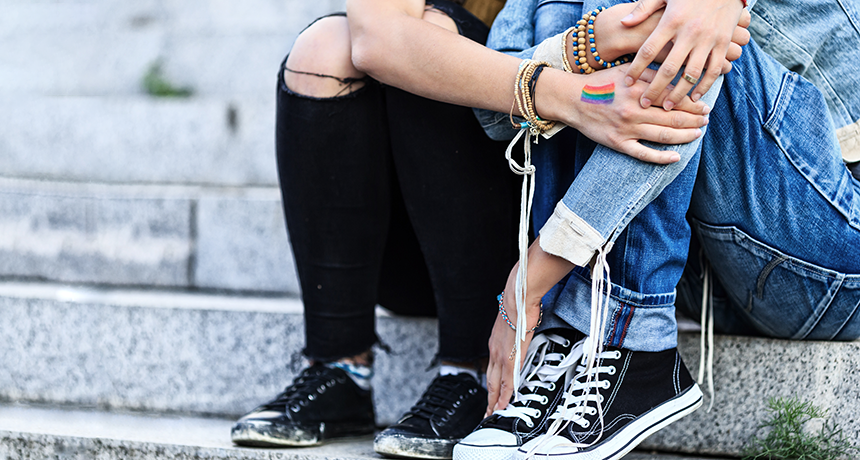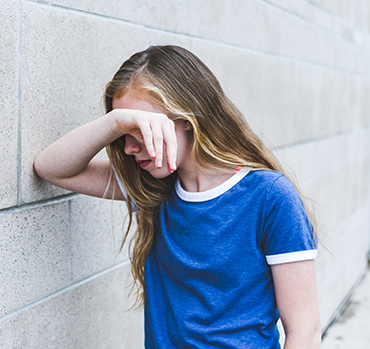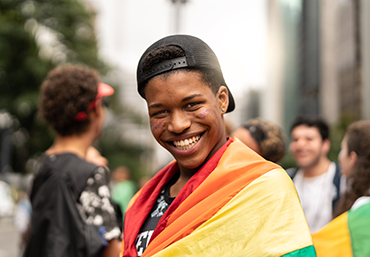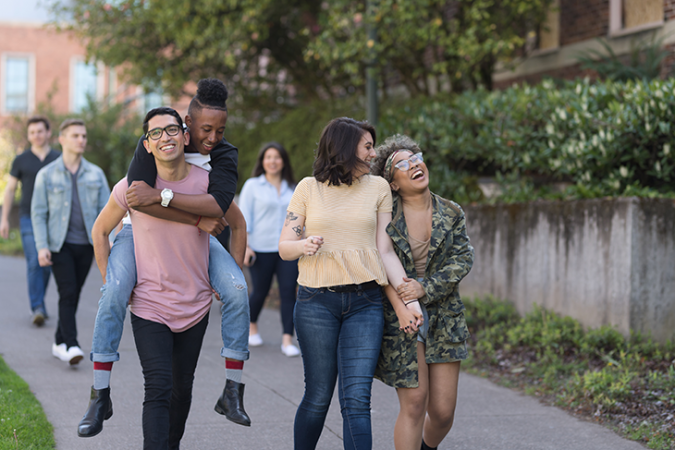Scientists investigate suicide risk among LGBTQ+ teens
Problems stem from how society treats people in sexual minority groups

LGBTQ+ youths face higher risks of suicide due to how society treats them. But there are plenty of resources available when help is needed.
valentinrussanov/E+/Getty Images Plus
Chloe was 12 or 13 years old when she began to question her sexual identity. She felt attracted to girls. She knew she was different from most of her classmates. So she didn’t talk about her feelings at school in the United Kingdom. She didn’t share them with her family, either. She knew they would not approve. “It wasn’t something that would be okay,” she said. A feeling of isolation built up inside her, and Chloe felt more and more like she didn’t fit in. Eventually, she tried to kill herself.
Sadly, Chloe was not an isolated case. The Youth Risk Behavior Surveillance System collects data from middle-school and high-school students in the United States. Data for 2017 show that 17 percent of all high school students — about one in six — seriously considered killing themselves.
That figure was nearly one in every two teens (almost 48 percent) for those who are lesbian, gay or bisexual. And 23 percent of these teens made attempts. Nearly one in three teens (32 percent) who were unsure about their sexuality also thought about ending their lives; 14 percent tried.
For this story, Chloe’s name has been changed. So have the names of others in this article who tried to end their lives. Fortunately, these young people survived. And they got support to deal with their problems.
Scientists have begun to dig into why suicide risks are higher for LGBTQ+ people, especially teens. (LGBTQ stands for lesbian, gay, bisexual, transgender and queer or questioning. The “+” refers to individuals who have sexual or gender identities that don’t fit into those other categories.) The problem, researchers say, seems to stem from how society treats members of these minorities. Changing attitudes toward these teens can help more of them live and thrive.
Anna Mueller is a sociologist at the University of Chicago in Illinois. Any suicide is one too many. That so many teens find life not worth living is a tragedy, she says. However, she adds, “There’s no reason that we can’t change the reality of the statistics that we see.”
Not being valued
Many LGBTQ+ teens are not “out” yet among their classmates. And most people don’t realize how many people are members of these sexual minorities. In a 2017 Gallup poll, 4.5 percent of U.S. adults said they were lesbian, gay, bisexual or transgender. There also are people who question their sexuality. Plus, there are other sexual minority groups, such as people with no sexual feelings. So LGBTQ+ groups likely include roughly one in every 20 people in the United States.
There’s no reason why being a sexual minority means a person must face a higher risk for suicide or other mental-health problems, Mueller says. “What does put kids at risk of suicide is when they feel rejected by families or friends or communities and when they feel ashamed of themselves.” Dealing with all of those stresses, she says, “can be really hard.”

Those feelings often emerge when society views those who are different through a lens of stigma. “Stigma is about not valuing people who are different,” explains Ian Rivers. It is about “viewing them as less worthy or less important.” Rivers is a psychologist at the University of Strathclyde in Glasgow, Scotland. When society treats people who are in a minority group as if they have less value, those individuals can feel serious stress.
Rivers and other researchers talked at length with Chloe and 16 other LGBT adults as part of a study. On average, the study participants were 17.5 years old when they first tried to end their lives. One was just 11 years old. What the team learned appeared in the September 2018 issue of Social Science & Medicine.
In some cases, stigma leads to bullying. “I was isolated from the boys and they started calling me sissy and things like that,” said Sirus, a study participant. The teasing turned into violence. And, he added, “the teachers did not pick it up.” So they did nothing about it.
In 2015, Mueller and her colleagues found a link between bullying and suicides of lesbian, gay and bisexual youths. As bullying increased, so did the rates for young people’s thoughts of ending their lives, the researchers reported in the American Journal of Public Health. But bullying didn’t fully explain why the rates for LGB youth were so much higher than for other young people. “This isn’t just about bullying,” Mueller explains. “It’s about a lot of other factors — like rejection from peers or families or shame.”
Those feelings came through when Rivers’ team talked with LGBT people. “I’ve always felt out of place at parties and things and social activities outside of class at school,” said Nicky. He’s a transgender man who participated in Rivers’ study. And that hurt, he said. “I always put a lot of emphasis on what other people think of me or what I think other people think of me.”
Stigma also can make people feel they’re alone. Donna is a lesbian in the study. After a girl she loved left school, “There was no one I could turn to and talk to about my feelings of loss,” she recalled.

Young people also can internalize other people’s bad attitudes. In other words, they come to believe what others say. So even though it’s not true, they might come to believe that they’re “not good” simply because they are experiencing a same-sex attraction, Mueller says. To make things harder, society typically assumes “that everyone is heterosexual.” That, she says, “automatically puts everyone who isn’t at a disadvantage.”
In Rivers’ study, a gay man named Thomas came from a very religious background. He came to believe that his attraction toward males made him a bad person. “I was convinced I was going to hell,” he said.
For Rivers and others, such stories are a call to action. “To allow young people to grow up feeling that they are not supported — causing anguish, anxiety, depression and social isolation — is something we have to tackle,” he says.
Younger is harder
Burdens created by a hostile social environment “fall hardest on the youngest people” in LGBTQ+ groups, says Geoffrey Ream. He’s a professor of social work at Adelphi University in Garden City, N.Y. Ream recently dug into data from the U.S. National Violent Death Reporting System. These data included 2,209 suicide deaths among people whose sexuality was known. Most who had died by suicide — 89 percent — were 18 or older. However, LGBT youth were 24 percent of the 49 victims ages 12 to 14. LGBT teens also made up 16 percent of the 15- to 17-year olds. For perspective, LGBT people made up a far smaller share — 8 percent — of suicides among 25- to 29-year olds.
Younger people “don’t have the same level of psychological resources” to cope with challenges that older people do, Ream explains. So children and teens are less ready to deal with the abuse that society may heap on them if they are part of a sexual minority. Youths also have fewer options to get out of the house and find resources to help.

Coming out can be very challenging at any age. But tweens and young teens are still “so close to the family’s orbit,” Ream says. So if a family has not handled stress well in the past, it can make the event especially hard for a young person, he notes.
He detailed his findings in the May 2019 Journal of Adolescent Health.
Family rejection is a big concern, agrees David Huebner. He’s a psychologist at George Washington University in Washington, D.C. He and others have found that parents’ rejection ups the risk of health problems, including suicide, among young adult LGB people. Name calling, physical violence and being kicked out of home are obvious examples of rejection. But rejection can also be more subtle. For example, parents might criticize a young person’s dress or behavior for not conforming to gender stereotypes.
“I don’t think that parents are bad people,” Huebner says. Some parents accept their kid’s identity immediately. Some never do. And others can take up to two years to adjust to a son or daughter coming out, Huebner and others reported last July in the Archives of Sexual Behavior.
Parents may struggle with the news “because they are exposed to all the same anti-LGBT messages from society that their kids are,” he says, But if parents take a long time to accept their son or daughter’s sexual identity, they may offer little support. And they’re more likely to behave in ways that feel like rejection to a young person. “That can certainly increase the child’s risk for suicide,” he says.
To make matters more complex, the teenage brain is very much a work in progress. That’s one reason that teens are more likely than adults to engage in risky behaviors. And the teen years present a lot of stresses. A sizable share — one in six U.S. high school students — have seriously thought about ending their lives, according to the Youth Risk Behavior Survey.
What can be done?

Fortunately, both straight and LGBTQ+ teens can take steps to help themselves and others — and to change the scary statistics. In a crisis, support is just a phone call away. In the United States, anyone thinking about hurting themselves can call or text the Suicide and Crisis Lifeline at 988. And 211 is an all-purpose crisis hotline.
Better still, you can take action before a crisis comes up.
Young people who haven’t yet come out should trust their gut on when the time is right, Huebner says. Don’t tell your family if you feel unsafe. But, he adds, “I have rarely heard of instances where the coming-out event went worse than a child thought.” He thinks that’s because most kids and teens don’t appreciate how much their parents love them. “Generally, parents respond better than they think,” he says. His group developed an online video and other resources to help.
Teens who hesitate to tell their family can go online to find a supportive community. “The nice thing is that in the age of the internet, you can really easily access groups like the Trevor Project or other organizations,” Mueller says. The Trevor Project offers confidential online chats and texts for LGBTQ+ youth. It also has a hotline number at 1-866-488-7386.
Troubled kids also can look for a friend, teacher, coach, doctor or other trusted person to talk with, suggests Rivers. “Realizing you are not alone and that people are out there ready to support you is the first step in combatting thoughts of suicide,” he says. “We all need allies at stressful times in our lives. LGBTQ+ young people need allies too.”
Some schools and communities also have clubs or alliances to create safe spaces for LGBTQ+ youth, Mueller notes. Straight teens can join many of those groups to show support for their friends and classmates.
And it’s especially important to speak up if you see bullying or homophobia — a hurtful intolerance of gays and other sexual groups, adds Mueller. When her younger brother was in eighth grade, he was one of the popular kids. When other kids made nasty remarks about LGBTQ+ people, he told them to stop. “My sister is gay, and I don’t ever want to hear you saying that again,” she recalls him saying. “It was really brave of him to do that.”
“Be kind and understanding. Empathize,” Rivers adds. In other words, put yourself in the other person’s position. Try to feel what they feel. And take the time to listen to them.
Kids also can ask that their school make sure its teachings reflect people’s diversity. Researchers at the University of Pittsburgh in Pennsylvania recently looked at whether inclusive sex-education classes could help improve teens’ mental health. On average, for every extra 10 percent of a state’s schools that taught about LGBTQ+ groups in sex-ed classes, rates of reported suicide plans dropped 20 percent for all youths in the state. The finding supports the idea that inclusive schools help everyone. Its findings appeared in the May 2019 Journal of Adolescent Health.
Learn more about what to do if a friend is in crisis. “Get trained. Get educated before it comes up,” Ream says. “Don’t freak out. But listen and have some idea of who you’re going to call and where you’re going to send them if it’s a serious crisis.” The Trevor Project’s Lifeguard Workshop has training materials online for teachers and students.
Also remember that most teens, including most LGBTQ+ youths, don’t try to end their lives. In fact, most LGBTQ+ people are happy and well-adjusted, Ream says. And they will join together to help others in need. “It’s important,” he adds, “for the young people to know that there’s this big community rooting for them and hoping they make it.”

Suicide is a complex issue, as are many mental-health problems. But those problems won’t get better if people try to hide them or treat them with shame. “Go ahead and break the silence,” Ream says. “Make it okay to talk about.”
“Young LGBTQ people have so much to offer the world,” says Rivers. Many of them are dynamic, clever and thoughtful people. “They are our future scientists, politicians, nurses, caregivers, parents, artists, humanitarians, advocates and scholars,” he adds. “Without these people, the world would be a poorer place.”
As of 2016, suicide is the second leading cause of death among youth and young adults between the ages of 15 and 29. If you or someone you know is suffering from suicidal thoughts, please seek help. In the United States, you can call or text the Suicide and Crisis Lifeline at 988. Please do not suffer in silence.







